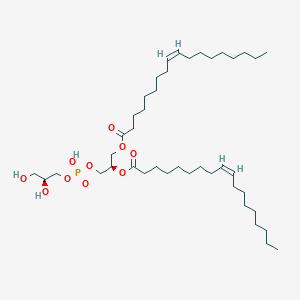| MeSH term | MeSH ID | Detail |
|---|---|---|
| Neuroblastoma | D009447 | 66 associated lipids |
| Hemolysis | D006461 | 131 associated lipids |
PG(18:1(9Z)/18:1(9Z))
PG(18:1(9Z)/18:1(9Z)) is a lipid of Glycerophospholipids (GP) class. Pg(18:1(9z)/18:1(9z)) is associated with abnormalities such as Neonatal hemochromatosis, Renal tubular disorder, Hereditary pancreatitis and UDPglucose 4-epimerase deficiency disease. The involved functions are known as Genetic Translation Process, Regulation, Saturated, enzyme activity and Cytokinesis. Pg(18:1(9z)/18:1(9z)) often locates in Membrane, soluble, Tissue membrane, membrane fraction and Thylakoid Membrane. The associated genes with PG(18:1(9Z)/18:1(9Z)) are COIL gene, P4HTM gene, GRAP2 gene, Integral Membrane Proteins and synthetic peptide. The related lipids are Liposomes, Fatty Acids, Sphingolipids, DOPE and 1,2-oleoylphosphatidylcholine.
Cross Reference
Introduction
To understand associated biological information of PG(18:1(9Z)/18:1(9Z)), we collected biological information of abnormalities, associated pathways, cellular/molecular locations, biological functions, related genes/proteins, lipids and common seen animal/experimental models with organized paragraphs from literatures.
What diseases are associated with PG(18:1(9Z)/18:1(9Z))?
PG(18:1(9Z)/18:1(9Z)) is suspected in Renal tubular disorder, Hereditary pancreatitis, Neonatal hemochromatosis, UDPglucose 4-epimerase deficiency disease and other diseases in descending order of the highest number of associated sentences.
Related references are mostly published in these journals:
| Disease | Cross reference | Weighted score | Related literature |
|---|
Possible diseases from mapped MeSH terms on references
We collected disease MeSH terms mapped to the references associated with PG(18:1(9Z)/18:1(9Z))
PubChem Associated disorders and diseases
What pathways are associated with PG(18:1(9Z)/18:1(9Z))
There are no associated biomedical information in the current reference collection.
PubChem Biomolecular Interactions and Pathways
Link to PubChem Biomolecular Interactions and PathwaysWhat cellular locations are associated with PG(18:1(9Z)/18:1(9Z))?
Visualization in cellular structure
Associated locations are in red color. Not associated locations are in black.
Related references are published most in these journals:
| Location | Cross reference | Weighted score | Related literatures |
|---|
What functions are associated with PG(18:1(9Z)/18:1(9Z))?
Related references are published most in these journals:
| Function | Cross reference | Weighted score | Related literatures |
|---|
What lipids are associated with PG(18:1(9Z)/18:1(9Z))?
Related references are published most in these journals:
| Lipid concept | Cross reference | Weighted score | Related literatures |
|---|
What genes are associated with PG(18:1(9Z)/18:1(9Z))?
Related references are published most in these journals:
| Gene | Cross reference | Weighted score | Related literatures |
|---|
What common seen animal models are associated with PG(18:1(9Z)/18:1(9Z))?
There are no associated biomedical information in the current reference collection.
NCBI Entrez Crosslinks
All references with PG(18:1(9Z)/18:1(9Z))
Download all related citations| Authors | Title | Published | Journal | PubMed Link |
|---|---|---|---|---|
| Berkut AA et al. | Structure of membrane-active toxin from crab spider Heriaeus melloteei suggests parallel evolution of sodium channel gating modifiers in Araneomorphae and Mygalomorphae. | 2015 | J. Biol. Chem. | pmid:25352595 |
| Jobin ML et al. | The role of tryptophans on the cellular uptake and membrane interaction of arginine-rich cell penetrating peptides. | 2015 | Biochim. Biophys. Acta | pmid:25445669 |
| Tavano R et al. | The peculiar N- and (-termini of trichogin GA IV are needed for membrane interaction and human cell death induction at doses lacking antibiotic activity. | 2015 | Biochim. Biophys. Acta | pmid:25306964 |
| Sharmin S et al. | Effects of Lipid Composition on the Entry of Cell-Penetrating Peptide Oligoarginine into Single Vesicles. | 2016 | Biochemistry | pmid:27420912 |
| Versluis F et al. | Negatively Charged Lipid Membranes Catalyze Supramolecular Hydrogel Formation. | 2016 | J. Am. Chem. Soc. | pmid:27359373 |
| Watanabe R et al. | Arrayed water-in-oil droplet bilayers for membrane transport analysis. | 2016 | Lab Chip | pmid:27080052 |
| Steinkühler J et al. | Modulating Vesicle Adhesion by Electric Fields. | 2016 | Biophys. J. | pmid:27705768 |
| Harrison PL et al. | Phospholipid dependent mechanism of smp24, an α-helical antimicrobial peptide from scorpion venom. | 2016 | Biochim. Biophys. Acta | pmid:27480803 |
| Kostritskii AY et al. | Adsorption of Synthetic Cationic Polymers on Model Phospholipid Membranes: Insight from Atomic-Scale Molecular Dynamics Simulations. | 2016 | Langmuir | pmid:27642663 |
| Kawatake S et al. | Evaluation of diacylphospholipids as boundary lipids for bacteriorhodopsin from structural and functional aspects. | 2016 | Biochim. Biophys. Acta | pmid:27301269 |
